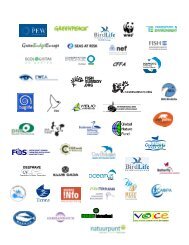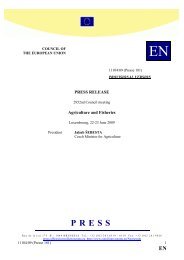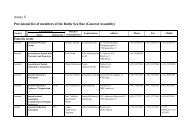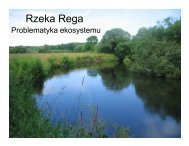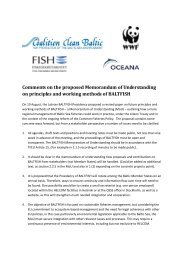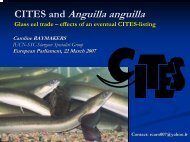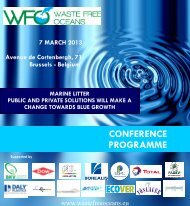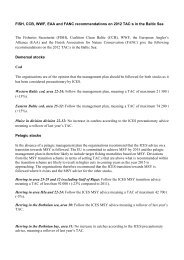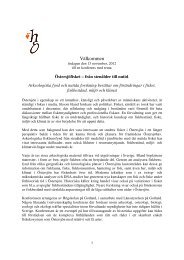A report on iUU fishing of Baltic Sea cod - Fisheries Secretariat
A report on iUU fishing of Baltic Sea cod - Fisheries Secretariat
A report on iUU fishing of Baltic Sea cod - Fisheries Secretariat
Create successful ePaper yourself
Turn your PDF publications into a flip-book with our unique Google optimized e-Paper software.
highest allowable level <strong>of</strong> dioxin in food enteredinto force <strong>on</strong> 1 July 2002. Sweden has an exempti<strong>on</strong>from these rules relating to fish from the<strong>Baltic</strong> sold for human c<strong>on</strong>sumpti<strong>on</strong>, implyingthat products whose dioxin levels exceed theselimits can be placed <strong>on</strong> the Swedish market. Thisderogati<strong>on</strong> is currently in place until the end <strong>of</strong>2006 (RSPB, 2004).The table below shows the total <str<strong>on</strong>g>report</str<strong>on</strong>g>ed landings<strong>of</strong> fish by Swedish vessels for human c<strong>on</strong>sumpti<strong>on</strong>and reducti<strong>on</strong> purposesYear Coastal For human Fordistrict c<strong>on</strong>sumpti<strong>on</strong> reducti<strong>on</strong>2003 West Coast 28,628 27,256South Coast 24,540 3,909E east Coast 15,163 6,710TOTAL 68,331 37,8752004 West Coast 31,489 24,893South Coast 24,439 6,255E east Coast 14,218 9,548Source FAO, 2004aTOTAL 71,146 40,696Most <strong>of</strong> the Swedish landings <strong>of</strong> herring andsprat from the <strong>Baltic</strong> are from the traditi<strong>on</strong>altrawl fishery with pelagic trawls as well as bottomtrawls for herring. Fishing with gillnetsfor herring is <strong>of</strong> local importance in the coastalfisheries, especially in the northern <strong>Baltic</strong>.The table below shows the total <str<strong>on</strong>g>report</str<strong>on</strong>g>ed landings<strong>of</strong> <strong>cod</strong> by Swedish registered vessels between1993 and 2004.Cod landings by Swedish vesselsYear 1993 1994 1995 1996 1997 1998Cod 12,048 22,190 27,966 36,119 28,374 16,609Herring 66,400 61,600 47,200 25,900 44,100 71,000Sprat 92,700 135,200 143,700 158,200 151,900 191,100Year 1999 2000 2001 2002 2003 2004Cod 15,927 19,172 21,026 14,588 14,585 14,163 *Herring 48,900 60,200 29,800 29,400 31,800 29,300Sprat 137,300 120,600 85,400 77,300 63,400 78,300* preliminarySource: adapted from ICES, 2005The processing sectorIn 2002, the fish processing industry in Swedenwas dominated by a relatively small number <strong>of</strong>large companies located <strong>on</strong> the Swedish westcoast. There were 184 companies involved inthe processing sector in 2002. Many Swedishcompanies have been bought by or merged withNorwegian or Icelandic companies. This developmenthas increased the availability <strong>of</strong> raw materialto the Swedish industry, and has also been away for Norwegian and Icelandic companies toget access to the EU market (FAO, 2004a).Total employment in the industry in 2002 was1,804 employees, a decrease <strong>of</strong> 16 per centcompared with 2001. Swedish fish processingcompanies import about 80 per cent <strong>of</strong> their rawmaterial. Their main output is herring and <strong>cod</strong>products, but they also produce prawn, salm<strong>on</strong>,mackerel and haddock products. The majority <strong>of</strong>imports come from Norway and Denmark (FAO,2004a).FINLANDThe arctic climate is an important characteristic<strong>of</strong> the Finnish fisheries, with coastal waterscovered by ice to varying degrees for part <strong>of</strong> theyear. This means that the main <strong>fishing</strong> periodlies between April and November but ice <strong>fishing</strong>using nets, hooks and traps is also comm<strong>on</strong> inthe winter seas<strong>on</strong> (FAO, 2005).While ec<strong>on</strong>omically important in some coastalregi<strong>on</strong>s the <strong>fishing</strong> industry is not a significantec<strong>on</strong>omic force, c<strong>on</strong>tributing about 0.1 and 0.2per cent <strong>of</strong> the nati<strong>on</strong>al GDP in 2000 (FAO,2005; OECD, 2005b).The commercial fleet is largely comprised <strong>of</strong>smaller vessels, with the majority <strong>of</strong> the vesselsless than 18 metres in length. Most <strong>fishing</strong> effortis focused in the coastal waters, but the largestvolumes are caught in the <strong>of</strong>fshore fisheries. Themost important commercial species is <strong>Baltic</strong> herringfollowed by salm<strong>on</strong>, whitefish (Coreg<strong>on</strong>uslavaretus) and sprat. Finland catches the sec<strong>on</strong>dlargest amount <strong>of</strong> fish for feed in the EU, afterDenmark. Most <strong>of</strong> the herring and sprat are usedin industrial processing for animal feed for thefur farming industry (FAO, 2005).In 2003 there were about 1,000 full-time fishermen– in this instance, classed as any<strong>on</strong>ereceiving more than 30% <strong>of</strong> their income from<strong>fishing</strong> – and a further 1,700 part-time fishermen.The number <strong>of</strong> <strong>fishing</strong> vessels was estimated tobe about 3,494 in 2003. 95% <strong>of</strong> the vessels areshorter than 12 metres (OECD, 2005b).– 54 –



